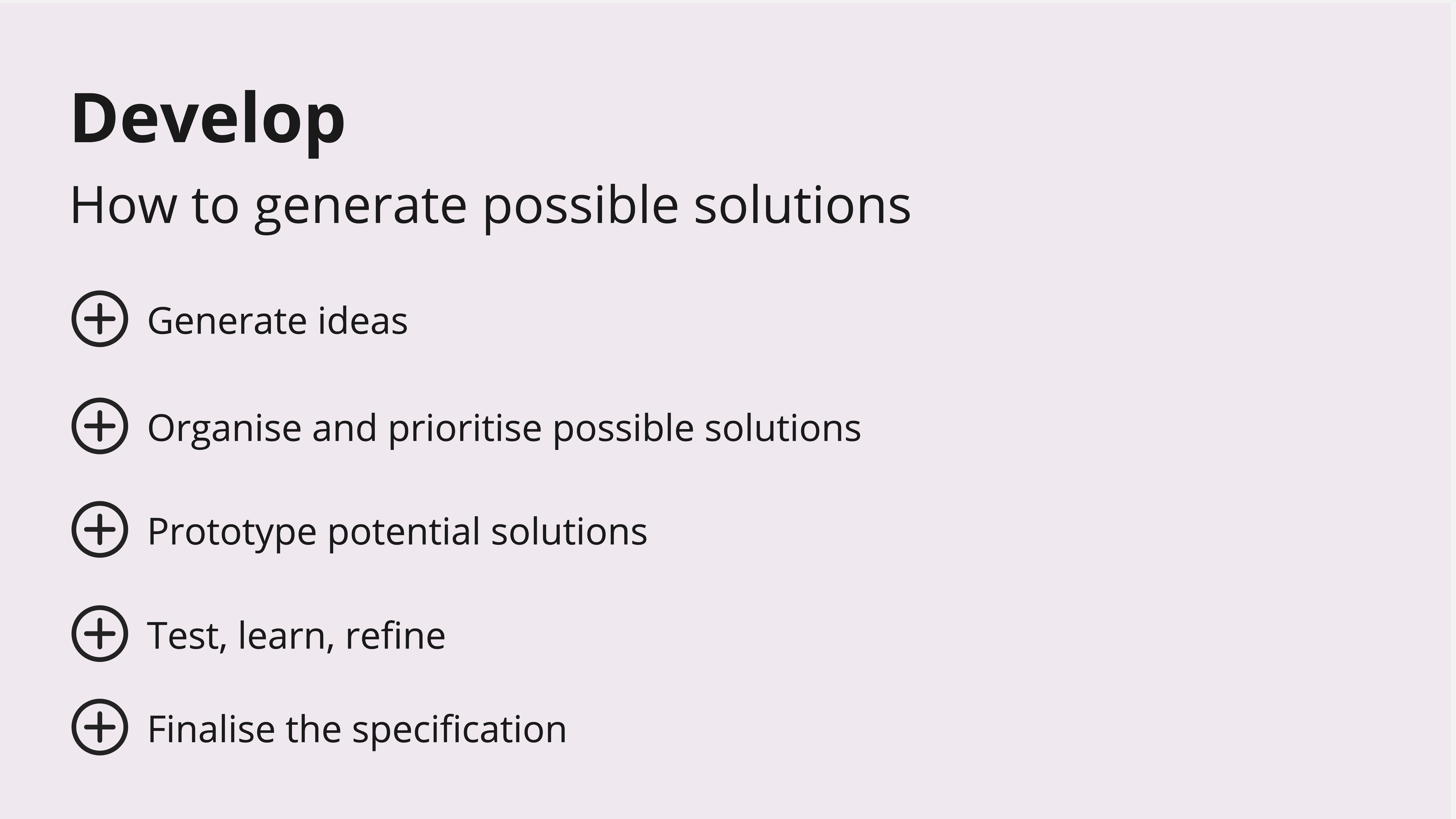How to generate possible solutions
Co-create possible solutions that can be prioritised in line with service user needs and other success criteria. Prototype, test and refine to find the ideal solution.

Generate ideas
Find possible solutions to the problem by involving different stakeholders who can bring a broad range of perspectives. Work collaboratively to co-create as many ideas as you can. Be ambitious!
- Do you have a plan for how you will run the sessions: how many, how long will they last, where will they take place, how will they be structured?
- Which stakeholders will you involve to draw from multiple sources of ideas?
- Have you considered involving subject experts, delivery partners, external organisations and even some ‘wild card’ contributors?
- How many participants will be invited?
- Which idea generating tools will you use?
- Are the planned activities appropriate for the number and characteristics of participants?
- Have you looked for inspiration from other sources, including from outside of your sector?
Organise and prioritise possible solutions
Make sense of multiple ideas by organising them into clusters of potential solutions that meet the user needs. Prioritise multiple possible solutions that meet the success criteria selected.
- Have you clustered the many ideas generated to reveal a number of possible solutions?
- Have you reviewed the possible solutions against the success criteria?
- Have you taken organisational parameters and constraints eg funding, procurement policy, governance into account?
- Have you considered cost-effectiveness and the longer term cost implications of solutions?
- Have you considered the reuse or integration of existing resources eg technology components?
- Have you prioritised possible solutions in line with service user needs and success criteria?
Prototype potential solutions
Bring ideas to life in a way that they can easily be shared and understood by service users and other stakeholders. Use visual techniques to engage and clearly communicate the idea and gather feedback.
- Have you visualised what success looks like for each solution?
- Which tools and techniques will you use to prototype the solutions?
- How many solutions will you prototype?
- Are the needs of service users and others key stakeholders central to the design?
- Which low-tech prototypes will you create eg sketches, storyboards, role play scenarios and wireframes?
- Who has design skills in the team who can work with you to create prototypes?
- Later in the process, what high-fidelity prototypes will help depict the solution eg detailed blueprints, interactive apps, or scale models?
Test, learn, refine
Test the prototyped solutions early and often to find out how well they meet the needs of service users and others who interact with them. Use the feedback gathered to assess the solution and refine it before testing again.
- Do you have a plan for how you will run user testing sessions: how many sessions, how long will they last, where will they take place, how will they be structured?
- Do you have a spread of service users and stakeholders to involve, which will represent an appropriate variety of perspectives? Are there any under-represented or under-served users you need to be sure to include?
- How many will you involve to ensure feedback is representative?
- What questions will you ask?
- How will the feedback be recorded?
- Have your partners been involved to test assumptions and share learning?
- How many rounds of testing can realistically be delivered?
Finalise the specification
Create a detailed specification for the solution based on user testing of prototypes, input from key stakeholders, and review of success criteria.
- Have you documented the process of identifying the ideal solutions/s to show how the decision has been made?
- Have you ensured that, where possible, materials created are in a sharable or reusable format, e.g personas, interview templates, digital code, and prototypes?
